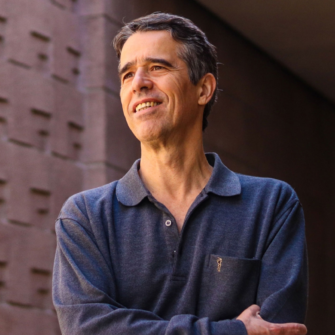Eastman’s electronic music composition studio is much different today than it was when new faculty member Mikel Kuehn ’93E (MA), ’95E (PhD) (pronounced “Michael Keen”) was a student in the early 1990s. Back then, says Kuehn, the computers were slow and the equipment finicky. It was the result of the nascent audio, recording, and computing technologies Eastman invested in, which put Eastman on the map as a major place to study early currents in electronic music composition. Kuehn says that then-director Allan Schindler, for whom Kuehn served as a TA, was “great at keeping things running and getting the latest and greatest thing in computing.”
Now the studios have much more advanced computers and expensive microphones and speakers, along with other sound modulating toys. However, Kuehn’s arrival this fall as a professor of composition and the new director of the Electroacoustic Music Studios @ Eastman or EMuSE (formerly the Eastman Audio Research Studio or EARS) marks an even newer moment for the longtime electronic music studio.
Not only will Kuehn be responsible for outfitting studios with even newer technologies and expanding the studio’s spaces—he has started on plans to double the current studio space—but he has also already given Hatch Recital Hall an important audio facelift. It now includes a 10.1 Genelec speaker system, which will enable a flexible combination of speaker configurations and immersive sound experiences, elevating the possibilities for performances of electronic music works.

João Pedro Oliveira | Howard Hanson Visiting Professor of Composition
Hatch’s new sound system will be on display twice in the coming week, and several times across the semester, totaling five concerts over the academic year with each featuring major guest artists. The first is on Saturday, September 23 at 7:30 p.m. featuring Howard Hanson Visiting Professor João Pedro Oliveira, a Portuguese composer who specializes in electroacoustic music. The next is on Thursday, September 28 at 7:30 p.m., featuring one of the most influential individuals and composers in electronic music, John Chowning.
“John Chowning is, if not the most famous living computer music figure, he’s up in the top three,” says Kuehn.
Chowning was responsible for developing something called FM synthesis, a way of combining sine waves together to enable new pitches and timbres. This development led him to collaborate with the Yamaha corporation to develop the famous DX7 synthesizer in the early 1980s.

John Chowning | Visionary of electronic music
“It quickly transformed the jazz world, the popular music world, and the electroacoustic music world—everything,” says Kuehn. “And to this day, there are many classics you listen to and without that technology, there would not be that music.”
By surveying Mikel Kuehn’s origins and trajectory, it seems written into the stars that he would end up at Eastman. Kuehn spent time as a toddler in Rochester while his father, David Kuehn ’78E (DMA), pursued a doctorate at Eastman, and his mother taught music in Rochester-area public schools. “I’ve known about Eastman since I could remember anything,” he says. He even studied percussion as a teen with Eastman graduate Michael Carney ’78E (MM).
Kuehn pursued his undergraduate studies at the University of North Texas as a jazz vibraphone major. He was drawn to the genre-breaking jazz of Herbie Hancock and Bill Evans. But there were limited opportunities as a vibraphone specialist. Something clicked, however, when he heard a concert of Bartok’s Sonata for Two Pianos and Percussion and Berio’s Circles. It was his freshman year.
“Those two pieces blew me away so much that the next day I went and changed my major to composition,” he says. “I thought, ‘there’s more to this.’ I really liked the idea of making up your entire piece, like the form, the harmonies, how it’s supposed to work, the rules, everything.”
Even with Eastman influences throughout his formative years, he didn’t consider Eastman until his North Texas professor Cindy McTee suggested going there to study with Joseph Schwantner for his graduate work. She told him, “I would love to go to Eastman to study with him.”

Mikel Kuehn | From his desk in the EMuSE Studio
At Eastman, Robert Morris was his PhD dissertation advisor, but he also learned from all the members of the composition faculty then, including Schwantner, Sam Adler, Christopher Rouse, and David Liptak. Kuehn attributes Eastman to helping him out of his introverted nature and developing good people skills, since Eastman students were always taking the initiative to perform and create music together.
After teaching for 25 years at Bowling Green State University, Kuehn is now on his third time back in Rochester. Of his goals in leading electronic music composition at Eastman, he wants to solve the matchmaking problem in electronic music. “Either composers are not in a position where they know performers that could play the kind of music they’re writing, or vice versa, performers don’t know composers that could help them or write a piece for them that uses technology.” With such high-level composers and performers at Eastman, “I think we’re poised to completely solve that.”
He calls having the opportunity to create new spaces and integrate new technologies at Eastman “a dream come true.” Yet, “the best part of it is actually the talent level of the students.”

